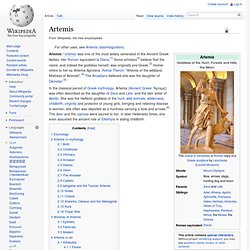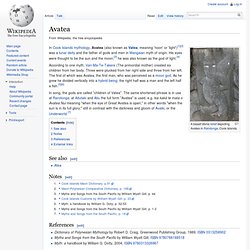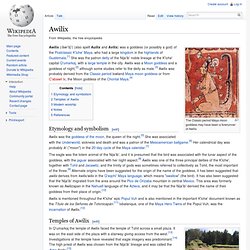

Achelois. Achelois was a name attributed to several figures in Greek mythology.

Aglibol. Palmyrene deities: from left to right: the lunar god Aglibôl, the supreme god Beelshamên, the sun god Malakbêl, 1st century CE, found near Bir Wereb, Wadi Miyah, Syria, Louvre Museum.

Aglibôl is depicted with a lunar halo decorating his head and sometimes his shoulders, and one of his attributes is the sickle moon. Aglibôl is linked with the sun god Yarḥibôl in a famous trinity. Alignak. Allah as Moon-god. Ibrahim Hooper of CAIR calls the Moon-God theories of Allah evangelical "fantasies" that are "perpetuated in their comic books".[6] Etymology[edit] The word Allah certainly predates Islam.

As Arthur Jeffrey states, Anumati (deity) Arianrhod. ( Welsh pronunciation: [arˈjanr̥ɔd] ) is a figure in Welsh mythology who plays her most important role in the Fourth Branch of the .

She is the daughter of Dôn and the sister of Gwydion and Gilfaethwy ; the Welsh Triads give her father as Beli Mawr . [ 1 ] In the her uncle Math ap Mathonwy is the King of Gwynedd , and during the course of the story she gives birth to two sons, Dylan Ail Don and Lleu Llaw Gyffes , through magical means. According to the Fourth Branch, Arianrhod's uncle Math fab Mathonwy would die if he did not keep his feet in the lap of a virgin when he was not at war.
Gilfaethwy conceives a lust for Math's original footholder, Goewin , and he and his brother Gwydion engineer a war with King Pryderi of Dyfed , forcing Math to leave his court. In his absence Gilfaethwy rapes Goewin, but is punished when Math returns (Math turns him and Gwydion into a series of mated pairs of animals). Gwydion suggests his sister, Arianrhod. Artemis. In the classical period of Greek mythology, Artemis (Ancient Greek: Ἄρτεμις) was often described as the daughter of Zeus and Leto, and the twin sister of Apollo.

She was the Hellenic goddess of the hunt, wild animals, wilderness, childbirth, virginity and protector of young girls, bringing and relieving disease in women; she often was depicted as a huntress carrying a bow and arrows.[6] The deer and the cypress were sacred to her. Artume. Artume in popular culture[edit] Artume appeared as a recurring character in Marvel Comics.[2] References[edit] Jump up ^ Thomson de Grummond, Nancy (2006).

Etruscan Myth, Sacred History, and Legend. Ataegina. Ataegina.

Marble, 210x93x72 cm, by the artist Pedro Roque Hidalgo. Museum of marble from Vila Viçosa (Portugal), 2008. Avatea. In Cook Islands mythology, Avatea (also known as Vatea; meaning 'noon' or 'light')[1][2] was a lunar deity and the father of gods and men in Mangaian myth of origin.

His eyes were thought to be the sun and the moon;[3] he was also known as the god of light.[4] According to one myth, Vari-Ma-Te-Takere (The primordial mother) created six children from her body. Three were plucked from her right side and three from her left. Awilix. The Classic period Maya moon goddess may have been a forerunner of Awilix.

Baal-hamon. Ba'al-Hamon (Punic: lbʻl ḥmn,[1] "Ruler of a Crowd or Multitude") was the chief god of Carthage.

He was a deity of sky and vegetation, depicted as a bearded older man with curling ram's horns.[2] Baʿal Hammon's female cult partner was Tanit.[3] Cult and attributes[edit] In Carthage and North Africa Baʿal Hammon was especially associated with the ram and was worshiped also as Baʿal Qarnaim ("Lord of Two Horns") in an open-air sanctuary at Jebel Bu Kornein ("the two-horned hill") across the bay from Carthage. Bendis. "Bendis" may also refer to comic book writer Brian Michael Bendis Artemis Bendis, molded terracotta figurine, (Tanagra?)
Chandra. In Hinduism, Chandra (Sanskrit चन्द्र lit, Telugu చంద్ర Tamil சந்திரன். "shining")[1] is a lunar deity and a Graha. Chandra is also identified with the Vedic Lunar deity Soma (lit. "juice").[2] The Soma name refers particularly to the juice of sap in the plants and thus makes the Moon the lord of plants and vegetation.[1] Chandra is described as young, beautiful, fair; two-armed and having in his hands a club and a lotus.[3] He rides his chariot across the sky every night, pulled by ten white horses or an antelope.
Chang'e. Chang'e or Chang-o[1] (Chinese: 嫦娥; pinyin: Cháng'é; Wade–Giles: Ch'ang2-o2), originally known as Heng'e or Heng-o (Chinese: 姮娥; pinyin: Héng'é; Wade–Giles: Heng2-o2; changed to avoid name conflict with Emperor Wen of Han), is the Chinese goddess of the Moon. Unlike many lunar deities in other cultures who personify the Moon, Chang'e only lives on the Moon. Chía (goddess) Chup Kamuy. Coyolxauhqui. Disk depicting a dismembered Coyolxauhqui which was found during construction in 1978 in Mexico City. Its discovery led to the excavation of the Templo Mayor. In Aztec mythology, Coyolxauhqui (Classical Nahuatl: Coyolxāuhqui [kojoɬˈʃaːʍki], "Face painted with Bells") was a daughter of Coatlicue and Mixcoatl and is the leader of the Centzon Huitznahuas, the southern star gods.
Coyolxauhqui was a powerful magician and led her siblings in an attack on their mother, Coatlicue, because Coatlicue had become pregnant. Attack on Coatlicue[edit] Elatha. In Irish mythology, Elatha or Elathan (modern spelling: Ealadha) was a prince of the Fomorians and the father of Bres by Eri of the Tuatha Dé Danann. The imagery surrounding him (he visits Ériu at night by sea on a silver boat) suggests he may once have been a moon god.
Fati. Gleti. Gleti is a moon goddess from the African kingdom of Dahomey, situated in what is now Benin. Hecate. Hina (goddess) "Mararu": Offerings of gratitude to Tahitian goddess Hina. Iah. Igaluk. Ilargi. Jarilo. The Slavic root jar or yar means spring or summer. Ka-Ata-Killa. Kalfu. As his name indicates, he also controls the crossroads and has the power to grant or deny access to all other Loa, or spirits, and he allows the "crossing" of bad luck, deliberate destruction, misfortune, and injustices.[1] When Kalfu mounts a person, everyone at the service stops speaking because he allows evil Loa to come to the ceremony. "He claims that most of the important Loa know him, and he collaborates with them.
When being ridden by Kalfu, Cheval are often stricken with black, weeping eyes, swollen muscles, and a need to show off how tall and strong they are. [citation needed] Kalfu likes to use tree leaves in his magic and is often seen helping people cope with personal problems, also acting as a master of the 'human condition.' Kalfu says that some people claim he is a demon, an allegation that he denies. Although other Loas recognize and know him, he is often a "Lone Wolf. " In popular culture[edit] Kalfu appears in the film The Zombie King played by actor Corey Feldman.[2] Kazaa. Kazaa Media Desktop was commonly used to exchange MP3 music files and other file types, such as videos, applications, and documents over the internet.
The Kazaa Media Desktop client could be downloaded free of charge; however, it was bundled with adware and for a period there were "No spyware" warnings found on Kazaa's website. During the past few years, Sharman Networks and its business partners and associates were the target of copyright-related lawsuits, related to the copyright of content distributed via Kazaa Media Desktop on the FastTrack protocol.
History[edit] Kazaa and FastTrack were originally created and developed by Estonian programmers from BlueMoon Interactive[1] including Jaan Tallinn and sold to Niklas Zennström and Janus Friis (who were later to create Skype and later still Joost and Rdio). Kidili. In Australian aboriginal mythology (specifically: Mandjindja), Kidili (or Kidilli) was an ancient moon-man who attempted to rape some of the first women on Earth. Khonsu. Kusuh. Kuu. Lona (mythology) Losna (mythology) Mahina (mythology) Mama Killa. Máni. Mano (mythology) Marama (mythology) Mayari. Men (god) Metztli. Napir. Nikkal.
Papare. Phoebe (mythology) Selardi. Selene. Silewe Nazarate. Sin (mythology) Ta'lab. Tarqiup Inua. Tecciztecatl. Tsukuyomi-no-Mikoto. Wadd. Yarikh. Yemaja.